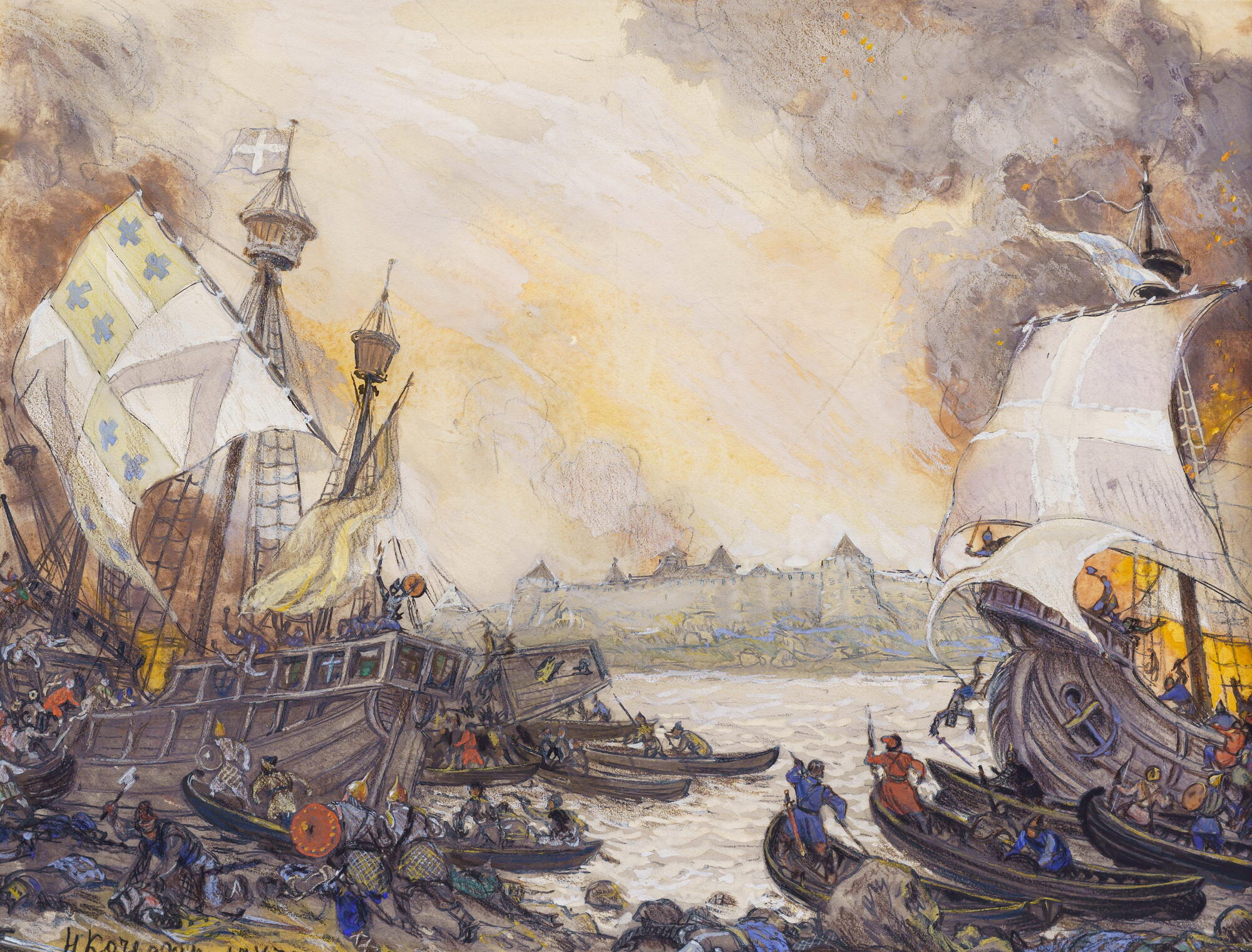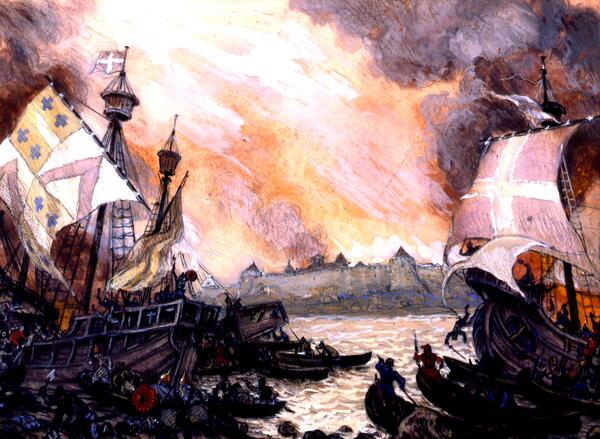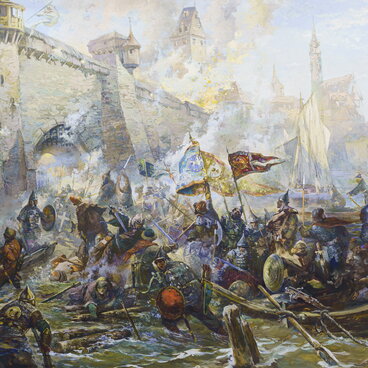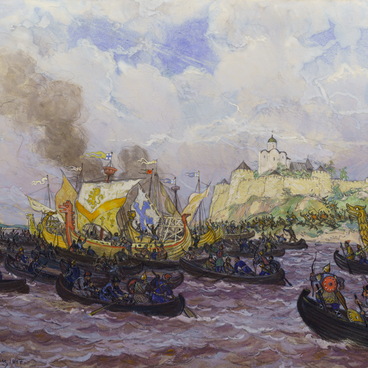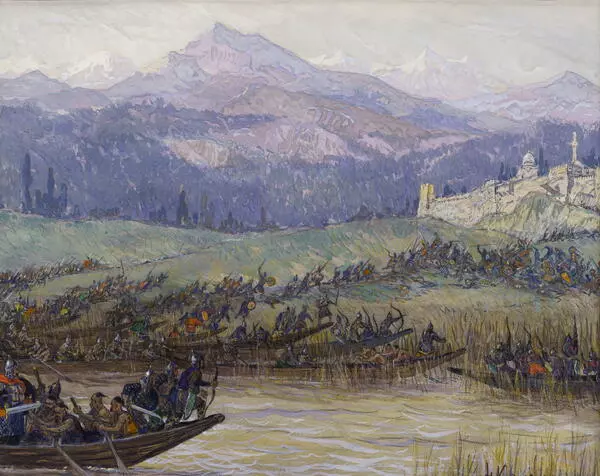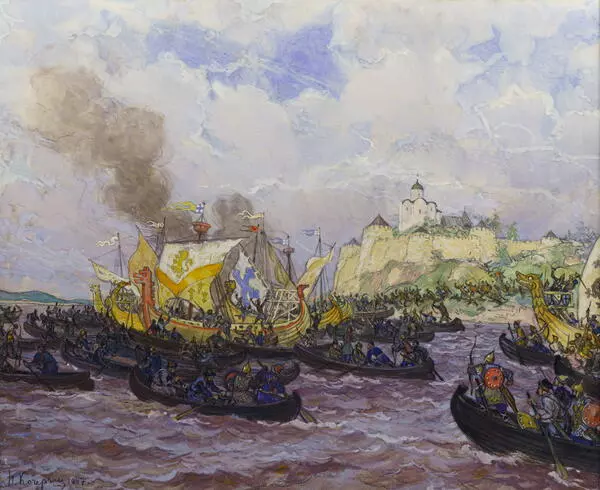The Novgorodians conducted long naval campaigns, fighting against their belligerent neighbors for the territories near Lake Ladoga and in the Neva estuary and protecting their trade routes in the Baltic Sea. Medieval books contain information on expeditions conducted by the Novgorodians in 1310, 1311, and 1318.
Between 1316 and 1323, residents of the coastal areas controlled by Veliky Novgorod repeatedly sailed to the coast of Scandinavia to have revenge upon the Norwegians for attacking Russian Orthodox vessels in the Arctic. In 1323, the Novgorodians undertook a major naval campaign against Vyborg. The same year, the Orekhovaya (Oreshek) Fortress near modern Shlisselburg was founded on an island near the head of the Neva River to prevent Swedish raids from the direction of the Gulf of Finland.
Because of the increased resistance on behalf of the Novgorodians, the Swedes often failed in their costly campaigns against Rus, which is why in 1323, they sent their representatives to the Novgorodian fortress of Oreshek offering peace. The Novgorodians accepted the offer of the Swedes and signed the Treaty of Oreshek (also known as the Treaty of Nöteborg) at the Oreshek Fortress. According to this treaty, the borders of the Novgorod Republic were defined by the Sestra River on the Karelian Isthmus, and the Narva River on the south coast of the Gulf of Finland. In 1326, Novgorod also signed a peace treaty with the Norwegians for a period of 10 years.
The Treaty of Oreshek signed in 1323 remained in force until 1348 when Magnus, the King of Sweden, decided to cut off access to the Baltic Sea for the Russians, capture their land, convert the locals to Catholicism, and enslave them. A large Swedish fleet commanded by the king himself entered the Gulf of Finland and, going up the Neva River, took the fortress of Oreshek. To free Oreshek, the Novgorodians drafted a large militia that marched and sailed toward the Swedes. Having found out about large Russian forces approaching them, the Swedish king left a strong garrison in Oreshek, while he and his retinue ran away to Sweden. In 1349, the Novgorodians stormed the Oreshek Fortress and retook it. After that, the Swedes avoided attacking Novgorod for a very long time. After freeing Oreshek, the Novgorodians founded a new fortress of Kantsy on the spot of the former Swedish fortress of Landskrona in the estuary of the Okhta River.
Between 1316 and 1323, residents of the coastal areas controlled by Veliky Novgorod repeatedly sailed to the coast of Scandinavia to have revenge upon the Norwegians for attacking Russian Orthodox vessels in the Arctic. In 1323, the Novgorodians undertook a major naval campaign against Vyborg. The same year, the Orekhovaya (Oreshek) Fortress near modern Shlisselburg was founded on an island near the head of the Neva River to prevent Swedish raids from the direction of the Gulf of Finland.
Because of the increased resistance on behalf of the Novgorodians, the Swedes often failed in their costly campaigns against Rus, which is why in 1323, they sent their representatives to the Novgorodian fortress of Oreshek offering peace. The Novgorodians accepted the offer of the Swedes and signed the Treaty of Oreshek (also known as the Treaty of Nöteborg) at the Oreshek Fortress. According to this treaty, the borders of the Novgorod Republic were defined by the Sestra River on the Karelian Isthmus, and the Narva River on the south coast of the Gulf of Finland. In 1326, Novgorod also signed a peace treaty with the Norwegians for a period of 10 years.
The Treaty of Oreshek signed in 1323 remained in force until 1348 when Magnus, the King of Sweden, decided to cut off access to the Baltic Sea for the Russians, capture their land, convert the locals to Catholicism, and enslave them. A large Swedish fleet commanded by the king himself entered the Gulf of Finland and, going up the Neva River, took the fortress of Oreshek. To free Oreshek, the Novgorodians drafted a large militia that marched and sailed toward the Swedes. Having found out about large Russian forces approaching them, the Swedish king left a strong garrison in Oreshek, while he and his retinue ran away to Sweden. In 1349, the Novgorodians stormed the Oreshek Fortress and retook it. After that, the Swedes avoided attacking Novgorod for a very long time. After freeing Oreshek, the Novgorodians founded a new fortress of Kantsy on the spot of the former Swedish fortress of Landskrona in the estuary of the Okhta River.
